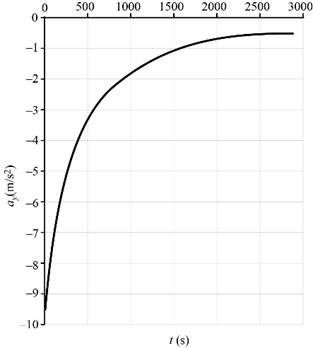
Concept explainers
In Example 2.6, we considered a simple model for a rocket launched from the surface of the Earth. A better expression for the rocket’s position measured from the center of the Earth is given by
where
a. Derive expressions for
b. Plot y(t), vy(t), and ay(t). (A spreadsheet program would be helpful.)
c. When will the rocket be at
d. What are
(a)
The expressions for
Answer to Problem 46PQ
The expression for
Explanation of Solution
Write the given expression for the position vector.
Here,
Velocity is the time derivative of position vector. Write the equation for velocity.
Here,
Acceleration is the time derivative of velocity. Write the expression for acceleration.
Here,
Conclusion:
Put equation (I) in equation (II).
Put equation (IV) in equation (III).
Therefore, the expression for
(b)
Plots of
Answer to Problem 46PQ
The plot of

The plot of

And the plot of

Explanation of Solution
The graph of position versus time of an object gives the position of the object at different instant of time. The slope of the position versus time graph gives the magnitude of the velocity of the object. In velocity versus time graph of an object, its velocity at different instants of time is plotted. The slope of this graph gives the magnitude of acceleration of the object. In acceleration versus time graph, acceleration is plotted as a function of time.
The plot of

The plot of

From the figure it is clear that the rocket has maximum velocity when it starts its motion and the velocity decreases with time. The graph has negative slope implying the acceleration is negative.
The plot of

From the figure, it is clear that the rocket has negative acceleration.
(c)
The time at which the rocket will be at
Answer to Problem 46PQ
The time at which the rocket will be at
Explanation of Solution
Equation (I) can be used to determine the time at which the rocket will be at
Substitute
Take the power
Conclusion:
Given that the radius of the Earth is
Substitute
Therefore, the time at which the rocket will be at
(d)
The value of
Answer to Problem 46PQ
The value of
Explanation of Solution
Equation (IV) can be used to determine the value of
Conclusion:
Substitute
Substitute
Therefore, the value of
Want to see more full solutions like this?
Chapter 2 Solutions
Physics for Scientists and Engineers: Foundations and Connections
- look at answer show all work step by steparrow_forwardLook at the answer and please show all work step by steparrow_forward3. As a woman, who's eyes are h = 1.5 m above the ground, looks down the road sees a tree with height H = 9.0 m. Below the tree is what appears to be a reflection of the tree. The observation of this apparent reflection gives the illusion of water on the roadway. This effect is commonly called a mirage. Use the results of questions 1 and 2 and the principle of ray reversibility to analyze the diagram below. Assume that light leaving the top of the tree bends toward the horizontal until it just grazes ground level. After that, the ray bends upward eventually reaching the woman's eyes. The woman interprets this incoming light as if it came from an image of the tree. Determine the size, H', of the image. (Answer 8.8 m) please show all work step by steparrow_forward
 Principles of Physics: A Calculus-Based TextPhysicsISBN:9781133104261Author:Raymond A. Serway, John W. JewettPublisher:Cengage Learning
Principles of Physics: A Calculus-Based TextPhysicsISBN:9781133104261Author:Raymond A. Serway, John W. JewettPublisher:Cengage Learning College PhysicsPhysicsISBN:9781285737027Author:Raymond A. Serway, Chris VuillePublisher:Cengage Learning
College PhysicsPhysicsISBN:9781285737027Author:Raymond A. Serway, Chris VuillePublisher:Cengage Learning

